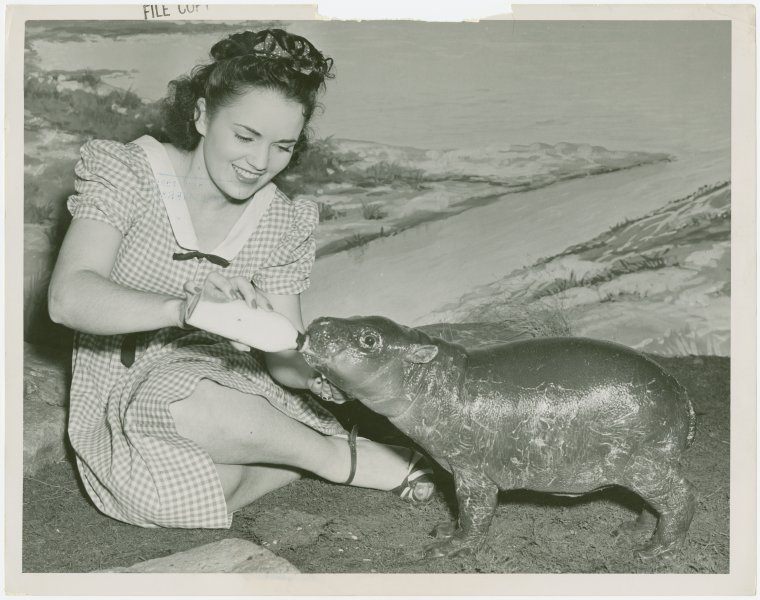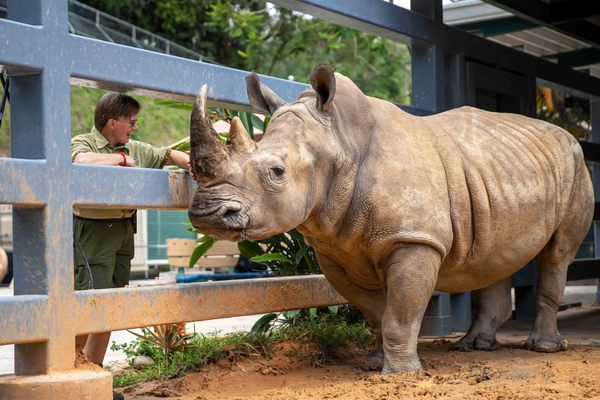Before Moo Deng, There Was ‘William Johnson Hippopotamus’
During the Roaring ’20s, the American National Zoo welcomed the first pygmy hippo superstar.
Ever since she was born at Thailand’s Khao Kheow Open Zoo in July 2024, Moo Deng, the pygmy hippopotamus, has captured public imagination, with visitors to her home quadrupling since her birth. She has also raised the profile of her species, the lesser-known—and more endangered—sheep-sized cousin of the common hippo. But Moo Deng was not the first mini hippo to become a major celebrity.
“Baby Hippo for Coolidge is Coming From Liberia,” the New York Times announced in May 1927. U.S. President Calvin Coolidge and his wife, Grace, were avowed animal lovers who filled the White House with cats, birds, and dogs, among other species. Earlier in 1927, the Coolidges had made the difficult decision to send their raccoon, Rebecca—once rescued from the Thanksgiving table—to live at a zoo. After Rebecca’s departure, the White House began to receive even more exotic animals as gifts from supporters. Many of these wound up at the National Zoo in Washington, D.C., anyway, although the Coolidges continued to visit and fund the upkeep of the critters they sent there. “President Coolidge has presented the National Zoo with more animals, sent to him by his admirers, than have any of his predecessors—Roosevelt alone excepted,” the New York Times wrote later in 1927.

So it was not out of the ordinary when Harvey S. Firestone, founder of the Firestone Tire and Rubber Company, announced that he was sending “Billy,” a live pygmy hippopotamus captured in West Africa, to the White House. Sources differ as to when it was decided that “Billy” was short for “William Johnson Hippopotamus,” but the name stuck. Whatever fondness the Coolidges had toward animals, there was nothing sentimental about the circumstances of Billy’s journey. Half-grown at 300 pounds, the hippo was captured after his rainforest home was destroyed by the encroachment of Firestone’s rubber plantations. Habitat loss is still the greatest threat facing wild pygmy hippos, said to number as few as 2,000 today.
By coincidence, Billy arrived in Washington, D.C., on the same day as aviator Charles Lindbergh after his own transatlantic voyage. But once Coolidge was done awarding a medal to Lindbergh, he turned his attention to Billy, setting up a home for him at the National Zoo. As only the eighth pygmy hippo ever brought to the United States, Billy was an especial curiosity and quickly drew crowds. The pygmy hippo had been known to Westerners only since the mid-19th century and was rarely observed in the wild due to its shy, nocturnal habits, meaning that Billy’s first caretakers knew little about his species. Despite this, Billy adjusted well to captivity, and was described in the New York Times as playing with his keeper, “frisky as a dog. Even the antics of the monkeys go unobserved when the keeper opens the tiny hippo’s cage and cuts up with him.”
Because of Billy’s good health and popularity, the zoo decided to acquire a mate for him in 1929. “Prior to this, the model for many zoos was to exhibit a single specimen of an animal until it died and then replace it with another,” Marguerite Roby, a Smithsonian photograph archivist, wrote in a profile of Billy in 2012. “This foray into hippo husbandry launched a new era of zoological parks as environments for the study of wildlife and animal conservation.”

However, zookeepers still had a lot to learn. Billy and his first mate, Hannah, were initially housed with lions. This is now believed to have stressed the hippos and played a role in the early deaths of their first three offspring. Media reports at the time often blamed Hannah for these deaths. In 1931, the Washington Post described the first calf as “ignored” and “neglected” by Hannah. After the death of the third calf, William Mann, the National Zoo director, told the paper that Hannah was “just a bad mother.”
Thanks to improvements to her enclosure, including separating the hippos from the lions, Hannah was noticeably more at ease during her fourth pregnancy in 1938. The resulting healthy calf was named Gumdrop, supposedly suggested by a child visiting the zoo. All of Billy’s subsequent progeny would be known as “Gumdrop,” followed by a Roman numeral indicating their birth order. By 1939, Billy and his growing family were so popular that they were transported to Queens, New York, for the World’s Fair and displayed at the Firestone pavilion. Billy, Hannah, and the Gumdrops continued to make media appearances in the 1940s and ’50s, including a 1952 photoshoot for Life magazine featuring Gumdrop XII following his mother and being toweled off after a bath.
The National Zoo sold or traded most of Billy’s offspring to other zoos once they reached maturity. Billy became so successful—and lucrative—as a “stud” for breeding that the zoo introduced a second mate for him, Matilda, in 1940. This prompted perhaps the greatest headline of Billy’s lifetime, from the Washington Post: “Pygmy Hippo to Become Polygamist.” Only a few of the 23 calves fathered by Billy were male. A high ratio of females to males is still observed in captive-born pygmy hippos, for reasons unknown to scientists.

Billy died in 1955 at around 30 years old, on the low end of a captive pygmy hippo’s lifespan today. The last Gumdrop was born to Hannah five months later. In a birth announcement in the Washington Post, a zookeeper said that Billy had “carried his work on to the end” by siring so many offspring. Today, most captive pygmy hippos in the United States are descended from Billy.
According to the International Studbook for the Pygmy Hippopotamus, there are now more than 1,600 pygmy hippos in zoos worldwide—almost as many as are believed to exist in the wild. While the animals are more popular and numerous in captivity than ever, their survival in nature is far less certain. Wild pygmy hippos have “nowhere else they can go” amid shrinking habitats, hippo specialist Gabriella Flacke told the BBC in 2024. Because the creatures are so rare and challenging to observe in nature, captive populations play a major role in their conservation and study. The story of Billy’s rise to fame is a reminder that our desire to see wild animals up close is nothing new, but also of how far we have come in understanding them.

































Follow us on Twitter to get the latest on the world's hidden wonders.
Like us on Facebook to get the latest on the world's hidden wonders.
Follow us on Twitter Like us on Facebook